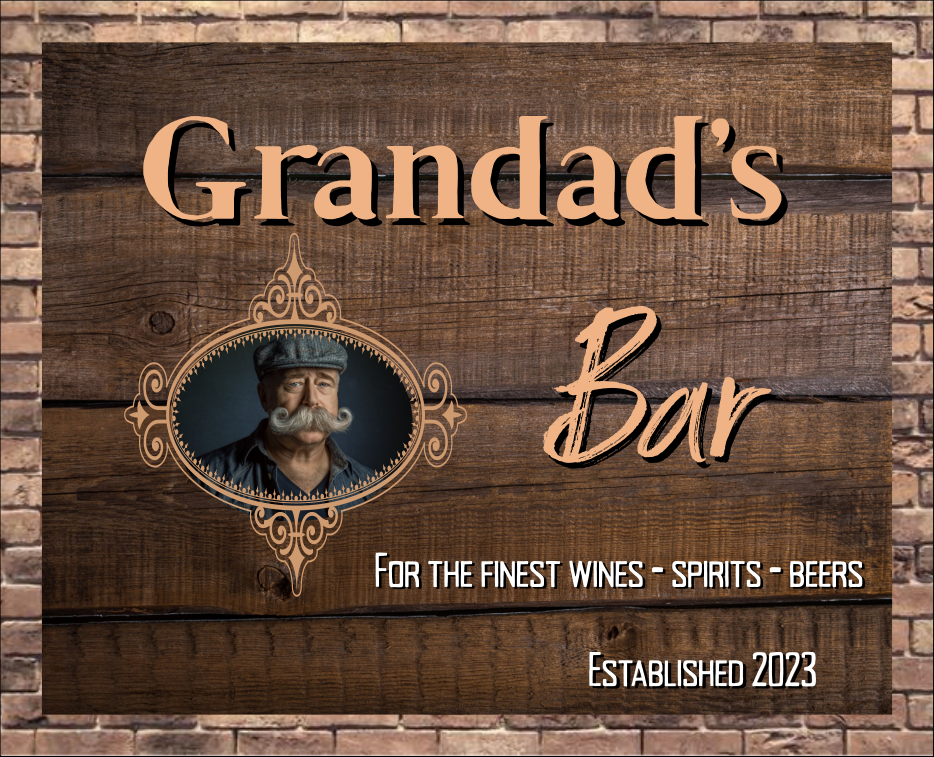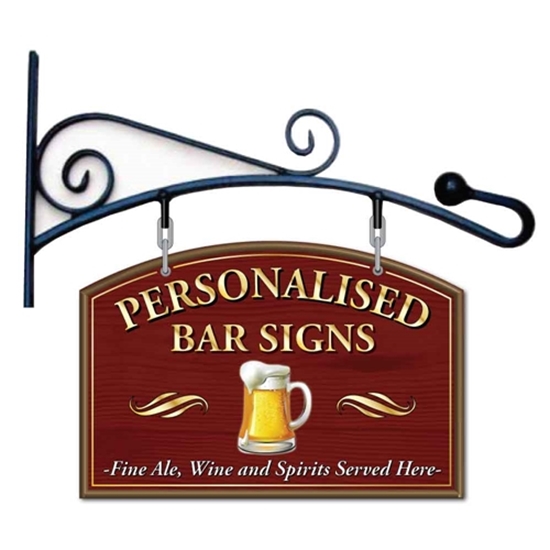Free Tips On Choosing Window Vinyl Signs
Free Tips On Choosing Window Vinyl Signs
Blog Article
How Do Bar Signs Differ In Terms Of Size?
There are various sizes for bar signs, based on the function of their design, where they're placed, and how they look. Here's a look at how size variations impact the effectiveness and appeal of bar signs:1. Large Signs
Use for: to focus attention on a specific region and to serve as a central place.
Uses: Exterior signage or primary branding signs.
Location - Usually, it is placed outside, above large entrances, or on walls with large openings to draw patrons.
For instance, large neon signs and vintage-style or large mural-type signage.
2. Medium Signs
The purpose is to add details or to enhance the look of the room without taking up the space.
Uses include menu boards as well as directions and displays for promotions.
Location: Ideally placed so that it is easily visible but not overpowering.
Signs with decorative designs or metal signs to advertise your bar.
3. Small Signs
Purpose: To offer specific information or to add subtle ornamental elements.
Uses: Table signs, decorative objects, labels, etc.
Placement: Tables, shelves or displays that allow for close-up view.
For instance, table number signs, small framed quotations, or drink menus.
Size Factors
Visibility
Large Signs are made to attract the attention of people passing by, and establish the bar’s presence.
Medium signs balance visibility with space efficiency to convey important information without overwhelming the décor.
Small Signs: Best for small-scale information and intimate details, enhancing the patron's experience from eye level or on a tabletop.
Proportion
To prevent overwhelming smaller areas the large sign should be proportional to the dimensions of the space. Ideal for large, open areas.
Medium Signs: Ideal for interior use They can be put anyplace.
Small signs: Ideal way to add detail, and they are a perfect fit for small spaces.
Impact
Signs that are large can create a bold statement, and they can also be used as a branding element. Bar signs can be used to establish a particular tone.
Medium Signs: Strikes the perfect balance between decor and visibility creating a welcoming ambience while delivering vital information.
Small Signs : These signs add detail and charm, creating an incredibly rich and multi-layered visual experience.
Practicality
Large Signs: These signs require substantial mounting solutions, and are also more expensive due to their size.
Medium Signs: Easy to set up, reposition and are flexible with design changes.
Small signs are perfect for locations that are constantly changing, such as bars that often change their menus and promotions.
Functionality
Large signs are mostly practical and appealing.
Medium Signs are functional and also decorative. They provide vital information as well as enhance the visual appeal.
Small Signs: Primarily functional to provide information in a clear manner, they contribute to the overall theme and decor with a subtle approach.
Choosing the right size for signs at bars is dependent on their intended function as well as the layout of the bar and the impact they want to have on patrons. Balance these elements to ensure the signs contribute to the overall atmosphere of the bar as well as the operational requirements of the bar. Take a look at the most popular bar hanging sign examples for more info including home pub signs, personalised bar signs, personalised pub signs for garden, novelty bar signs, personalised pub signs for sale, bar wall signs, personalised outdoor bar signs, make a bar sign, design your own bar sign, bar signs for garden and more.
What Is The Distinction Between Bar Signs And Other Types Of Signage In Light?
Lighting can have a major impact on bar signs, including their general impact, visibility and atmosphere. Here are some key ways lighting influences bar signs. Neon Signs
Characteristics: Bright, colorful, classic.
Lighting: Make use of neon gas-filled tubes that emit light when charged.
Uses: Perfect to create a vintage or retro look. Typically, it is used for logos or bar names as well as attractive designs.
Advantages: Visible even at a distance, and it has a nostalgic appeal.
Advantages: May be fragile and costly to repair.
2. LED Signs
Characteristics: Energy-efficient, versatile, modern.
Lighting: Make use of LEDs to produce bright and vibrant lighting.
Uses: It is suitable for indoor and outdoor signs, displays that can be programmed, and the effects of dynamic lighting.
Benefits include: long-lasting, energy-efficient. Animations and color shifts can be programed.
The initial costs can be high but you will reduce the cost of maintenance and energy.
3. Signs that are backlit
Characteristics: Elegant, sophisticated, subtle.
Lighting: Use LEDs and fluorescent lights behind transparent surfaces to produce soft, diffused light.
Applications: Typically used for modern bar menu boards, signs, and branding elements.
Benefits: A professional and clean appearance is achieved, which increases the readability in dim lighting.
Advantages: Simpler installation, however higher initial cost.
4. Signs using Edge-Lit
Characteristics: Sleek, contemporary, stylish.
Lighting: LEDs can be employed to light the edges of acrylic signs.
Applications: Ideal for contemporary, minimalistic styles.
Benefits: Energy efficient, it gives an attractive and elegant appearance.
Advantages: Only available in certain design styles.
5. Ambient/Accent Lighting
Characteristics: Subtle, atmospheric, decorative.
Lighting Direct lighting is used to emphasize or highlight certain the appearance of signs.
Uses: Helps create a tranquil atmosphere, and is often used in conjunction with themed décor or art.
Benefits: It adds an atmosphere and dimension to a room that creates a warm and warm atmosphere.
Insufficient direct illumination to read.
6. Marquee Signs
Characteristics: Bold, theatrical, eye-catching.
Lighting: Utilizes multiple LEDs and lights to light the sign.
Uses: Popular for exterior signs, event promotions as well as creating a vintage cinema-style look.
The design is prominent and attracts people's attention.
The downside is that it can be expensive and requires frequent maintenance.
7. Projection signs
Characteristics: Dynamic, innovative, versatile.
Lighting: project light and images using projectors on flat surfaces.
Applications include: promotions Events display, dynamic and temporary promotions.
Simple to modify There is no need to use physical signs.
Advantages
8. Fluorescent Signs
Characteristics: Bright, cost-effective, traditional.
Lighting: The use of fluorescent tubes for illumination.
Uses: Typically used on larger outdoor and indoor signs.
Benefits: Bright and effective for large-scale signs. Costs are relatively low.
Cons: They're less energy efficient than LEDs, and they can create an unnatural lighting.
Lights: Considerations for the Lighting
Visibility
Neon LEDs and neon signs can be extremely effective in grabbing people's attention, especially in low-light situations.
Backlit or edge-lit Signs: These are great to improve readability and also for giving a polished and professional look.
Energy Efficiency
LED Signs are energy-efficient. They also last for a very long period of time.
Signs in neon and fluorescent The reason for this is that neon is not as efficient in energy use.
Aesthetic Appeal
Neon Signs and Marquees: Ideal for retro and vintage style.
The perfect choice for modern and clean designs are edge-lit signs with backlighting.
Ambient Lighting: Improves the overall ambience and atmosphere.
Maintenance
LED Signs Lasting for a Long Time and Low Maintenance
Signs with fluorescent and neon lights require more frequent maintenance, and might require to be fixed.
Cost
Backlit and LED Signs: Higher upfront costs but lower operational costs.
Fluorescent signs are less expensive in the beginning cost, but more expensive energy over the long term.
Flexibility
Projection and LED Signs that can be programmed: They offer a high degree of flexibility when it comes to moving display and interactive content.
Traditional Signs are not as flexible but provide the desired look.
The right lighting can create the right atmosphere and communicate effectively with customers. See the best hanging pub signs for site tips including bar sign outdoor, personalised metal bar signs, pub signs for garden, hanging pub signs personalised, home pub signs, bar hanging sign, personalised outdoor pub signs, a bar sign, pub signs to buy, pub signs made and more.
What Is The Difference Between Interactive Signs?
Bar signs may have different levels of interaction to engage customers and improve the overall experience. Below are the distinctions between bar signs with respect to their interactivity. Static Signs
Static signs display information in an unchanging format.
Common types include: printed posters or painted murals.
2. Digital Displays
Digital signs are capable of showing live-time content, such as videos, multimedia, and updates.
Interactivity: Touchscreen displays may include interactive games, menus, or promotional content.
Benefits: Draw attention, deliver dynamic information and boost the participation of patrons.
3. QR Codes
Interactive Links QR codes that are printed on signs may link to menus, promotions or social media profiles.
Benefits of the app Access to more details and specials.
4. LED Screens
Dynamic Messaging: LED screens are able to display scrolling text, animations or video content.
Interactivity: LED screens with touch capabilities let patrons interact with the content including choosing menu items as well as playing games.
Benefits: Draw the attention of others, clearly communicate information and create an immersive experience.
5. Projection Mapping
Immersive Experiences Projection mapping transforms the surfaces and provides interactive images and also telling stories.
Interactivity: The patrons can engage with interactive elements, like games or virtual experience.
Benefits: Increase ambiance and social interaction, while creating memorable memories.
6. Augmented Reality
AR enhances the reality by overlaying digital media onto the physical world. This allows for interactive experiences.
AR enabled signs enable users to interact with virtual elements such as cocktail recipes or virtual games.
Benefits: Engage customers and provide unique experiences to distinguish your bar.
7. Motion Sensors
Motion sensors detect movement and trigger interactive response in signs.
Interactivity Signs respond to patron movements by displaying animations or altering the content. They also can send personalized messages.
Benefits Inspiring environments to make your guests feel special and delighted.
8. Social Media Integration
Online Interaction Signs: These can include social media handles and hashtags in order to entice customers to join online.
User-Generated Media: Encourage clients to share pictures of signage through social media sites. This can increase visibility and reach.
Benefits: Increase brand awareness and encourage involvement of the community.
9. Interactive Lighting
Interactive lighting: Signs with LED or neon lights that respond to motion, sound or motion.
Signs are interactive when people interact with them or when the setting changes.
Benefits Create immersive environments and increase ambiance. Captivate the attention of.
10. Gamification
Interactive Games: The signs include interactive games or challenges to draw attention of the public and inspire participation.
Reward: Offer discounts or other rewards to players who finish challenges or who win games.
The benefits include: extending the duration of stay, encouraging social interaction, and encouraging return visits.
Bar owners who include interactive elements into their signage can create engaging experiences that draw patrons' attention, increase brand recognition and distinguish them in a highly competitive market. Follow the top bar sign outdoor recommendations for site examples including hanging bar sign, buy bar signs, garden pub signs, personalised cocktail bar sign, pub sign design ideas, make a pub sign, personalised pub signs, to the bar sign, large personalised bar signs, large personalised bar signs and more.